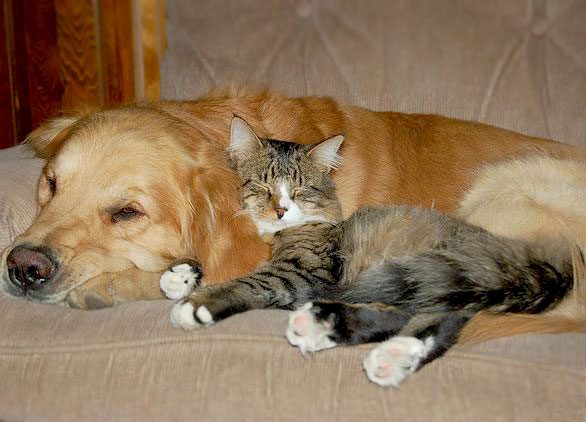 Multi-Pet Households
Multi-Pet Households
Many households successfully combine multiple pets – dogs and dogs, cats and dogs, birds and dogs, rabbits and dogs. However, this peaceful co-existence doesn’t always come easily, especially when it involves different species that communicate differently. Sparks (and fur) can fly when their signals are misinterpreted. Even multiple dogs may not always get along. The dogs’ breeds, physical characteristics, ages, health status, temperaments, and backgrounds can all affect their relationship. Although there is an adjustment period between dogs and they often work things out, ignoring the differences between your pets can lead to fights, injury, stress for both pets and humans, and, in the worst case, the death of a smaller pet.
Speaking different languages
Different species communicate differently. While both dogs and cats depend heavily on body language, the same posture may not mean the same thing coming from each species. Dogs use facial expressions to communicate, while cats make very little use of facial expressions. Body language that means “let’s play” for a dog may mean “back off” for a cat.
It is important to remember that even when your dog or cat learns to read the body language of cohabitating animals, this may not extend to a new dog or cat. Carefully introduce each animal in your household to the new resident, even if they have lived with the other species before.
Plan ahead
When preparing to get another pet, think carefully. Is the pet you are planning to acquire suited to the other animals in your home? Although breed should be considered, selecting the right match is more than a question of breed. For example, a senior cat may not appreciate a young Labrador that wants to play chase all day, but the cat may be happy to lounge in the sun with an older Lab.
If you are adopting the new pet, ask about his or her history. A dog with a history of aggression toward small animals will be a poor fit for a home with cats or free-range small mammals. An animal that has positive experience with other species may have an easier time adjusting to living with another pet. Regardless of the history of all animals involved, it is important to remember that every introduction requires relearning how to communicate with this new resident.
You may not have the option to choose which pets live together. We frequently combine pets from different households as a result of family changes, household needs, or even “foster failures”, where you have fallen in love with the animal and just can’t let it go. Whether you are a multi-pet household by choice or by circumstance, there are steps you can take to establish good relationships between your pets from the outset. Be prepared to take things slowly and orchestrate introductions carefully.
Start off on the right foot
You can help create a positive relationship between your pets by providing careful and patient introductions. You will need a second person to help; so, be prepared to ask a family member, friend, or neighbor. If you have multiple pets at home, introduce each one to the newcomer separately. When introducing dogs, choose a neutral location, rather than introducing them on the resident dog’s “home turf”. Perhaps, there’s a nearby school yard, field, or park. If not, you can try the end of your block or a neighbor’s driveway. It‘s important to keep in mind environmental stressors that may negatively impact the interaction, such as loud noises or a busy street.
Many dogs will behave differently on and off leash. You should start the introduction with both dogs leashed, walking parallel to each other at a distance. If that goes well, they can move closer. Let them walk side by side only when you are reasonably sure they will interact well together. If there is snarling, separate them calmly and start over. Do not punish, yank, or yell at them. You don’t want either one to form a negative association with the other. When you do go home, let them get used to each other (and go to the bathroom) outside before bringing them in. Keep them on leash, at first, in your home. Treats can be used both to reward good behavior (like looking at the other dog without barking) and to help establish positive associations with each other. Be careful of food aggression and never give the dogs treats right next to each other. Contact us for a referral to a positive trainer if you have serious concerns about your dogs’ off-leash meeting.
When the new resident is a cat, be prepared for the introductions to take time – from several days to several months. If you are introducing a new cat to your home, prepare a small room (such as a bathroom) with a litter box, food, water, and soft bedding. A scratching post and safe toy are also a good idea. Being in “his” room both allows your cat time and space to adjust to his new surroundings, and separates your new cat from your dog. Spend time playing with your cat. Fishing pole-type toys are great for this, since most cats love them, and you don’t have to worry about getting scratched. Although you will naturally be excited about your new pet, don’t forget that your dog still needs as much attention as before. You can help your pets adjust to each other by rubbing each with a towel to put under the other’s food bowl, so that each scent is associated with something positive. Do NOT rush this phase – it’s that important! Two to four weeks is a good period for gradual introductions.
If a dog is the new animal, try to minimize disruption to your cat’s space and routine. However, for the safety of pets and humans, you should separate your cat from the new dog until you can arrange a careful introduction. This is especially important if your cat has not lived with dogs. Set up a bedroom with a litter box, food, water, and bedding that can be closed off from the dog with baby gates. If you choose not to confine your cat, this room can be a safe area where your cat can go, without your dog being able to follow.
When you are ready to introduce your new dog to your cat, your dog should be on leash. The cat should be on leash or have easy access to a cabinet, bookcase, or other raised surface that will allow your cat to escape. Try exposing the pets to each other from a distance, perhaps from opposite ends of a hallway, and gradually decrease the distance between them. Expect hissing and barking. Do not allow either of the animals to approach the other closely enough to make physical contact. Keep the meeting brief and provide high value food treats to both animals – lots of treats while both pets stay in the same area. If your dog reacts badly, or even aggressively, toward the cat, don’t yell or yank on the leash; move your dog away calmly, so that he doesn’t associate the cat’s presence with negative consequences.
Expect the Unexpected
As helpful as it is to carefully select and gradually introduce new pets, life often throws us curves that take such decisions out of our hands. Maybe that puppy your son brought home from college is not the companion you would have chosen for the old family cat, or you married someone with his own pet. If you are still in the introduction stage, follow the steps outlined above. Expect the introduction between two animals that are not well-suited to be slow, possibly requiring weeks or even months, before they can tolerate each other. They may always require careful management, including separating them when unsupervised.
If the animals have already been introduced, but the relationship is rocky, you may need to consider separating them and starting again with a new, slower introduction. In other cases, careful management, discussed below, may help to improve their relationship.
Always keep in mind the quality of life for both animals and people. If your cat is spending all his time in the basement to steer clear of the dog or your shy dog is sneaking around in fear of your assertive cat, your pet’s quality of life will suffer. The strain can also affect human members of the family, who may feel guilty about the stress to their animal companions or irritated by the need for constant concern. By going slowly with your introduction and managing experiences to avoid setbacks, you can help preserve the quality of life for all human and animal family members while working to build a better relationship.
Careful management is key
Management is key to improving your dog’s behavior, and it is one of the most important aspects of promoting successful relationships in multi-pet households. The main principle of management is to prevent your pets from practicing unwanted behaviors. For example, dogs should be kept on leash around cats and small animals until they can be trusted not to chase them. Start by holding the leash or tethering it to a stairway or heavy furniture. Once chasing behavior subsides, you can let the dog move about freely, but consider keeping a lightweight leash on the dog to quickly stop any chasing behavior. An old leash with the handle cut will allow your dog to move around without getting hung up – but still allow you to catch the leash if needed. Never allow dogs to play chase games with cats or smaller dogs, as these can too easily result in injury to one or both of your pets. It doesn’t mean that either animal is bad; it’s just the way dogs and cats (or rabbits, or guinea pigs, or birds) interact. Unrestrained prey drive can result in the death of a smaller pet; so, manage, manage, manage!
Do not leave pets alone together unconfined until they have completely adjusted. While it may seem like a waste of time to separate animals that get along most of the time, it is easy for problem behaviors to escalate when animals are unsupervised. This may lead to a setback in your pets’ relationship or physical harm to one or more of your pets. Leave your dog with water, a bed, and a safe toy or stuffed Kong in a room or crate while you’re out. Training your dog to LOVE his crate is a great way to protect all of the household pets. Cats can be confined in a room with a litter box, water, food, and a soft bed. Once you feel comfortable leaving your pets alone together, make sure your cat always has a safe place to get away from your dog, such as a high shelf or cabinet. Cat “trees” are great for this purpose.
Be aware of possible food aggression and other resource guarding. (Read our handout on resource guarding.) Even an animal that readily allows YOU to take food and toys may aggressively guard these resources from another animal. Your pets should always start out with their own food and water bowls. If you are not sure if they may become aggressive about toys, pick up toys, including children’s toys, and chews, like bully sticks or antlers. Dogs that snarl or fight over food or toys can be separated to eat or play in different rooms.
Not every relationship is the same
It’s important to remember that just because your own dog and cat or pet dogs get along, that doesn’t mean that they will necessarily get along with a different cat or dog. You also can’t ensure that animals that were friends at the foster’s home will be fine with your pets. Dogs do not generalize well. A cat that was best buds with the dog he lived with as a kitten may only tolerate your new puppy. A shy cat may steer clear of a noisy dog, but be perfectly happy curled up next to a quiet one. Recognizing these differences in relationships is important. Allow your pets time to adjust to the new resident in their home, and provide the resources they need to feel comfortable and safe. Remember to generously reward behaviors you want and manage (not punish) behaviors you don’t want.
Past performance does not predict future performance
Inter-species relationships can and do change over time. Always be aware of your pets’ behavior and note differences in their relationships. A change in one animal’s health status, a new pet, or the death of a pet may change the dynamic between long-time resident animals. You may need to temporarily separate them to give them time to adjust. You should also consider preemptively separating your pets when one is ill or recovering from surgery, in order to prevent any problems from developing. If age or illness means that one of your pets can no longer be the playmate the other is counting on, be prepared to step in and take up the slack to prevent boredom and bad behavior.
Consider the use of anxiety reducing products when introducing new pets and when household changes are dramatic. These might include a Thundershirt for an anxious dog or plug-in diffusers/sprays of DAP (for dogs) or Feliway (for cats). Don’t rule out the possibility of temporary drug therapy, prescribed by your veterinarian or a veterinary behaviorist, for one or more pets, if a major environmental or lifestyle change has occurred.
Conclusion
Interspecies relationships can be awesome. Just look at the relationship between most dogs and their people! On the other hand, some of those interspecies relationships need time to develop, and some are just not a good idea, such as terriers and pet rodents. Your obligation is to protect both species and to carefully supervise their interactions until you can tell whether or not your pets seem safe together. If they aren’t, you should either keep them separate or seek to rehome one of them. We understand how heartbreaking this can be, but it may be best for both your family and your pets.
Key points to remember:
- Carefully consider your choice when bringing another pet into your home. Although each dog is an individual, some dog breeds were bred to kill smaller animals. If this is an issue, why take a chance, when there are plenty of other great dogs to choose?
- Introduce animals carefully and supervise them until you feel confident that they can be alone together. Err on the side of safety.
- Don’t rush introductions because you think your pets “should” get along or have gotten along with other animals in the past.
- Good management can prevent problems from developing.
- Provide each pet with a “safe space” to get away and feel secure.
- Help establish positive associations to encourage good behavior.
- Remember that changes in health status, environment, or the loss of one pet can lead to changes in the relationships between even long-time companions.
Resources:
Feeling Outnumbered? How to Manage and Enjoy Your Multi-Dog Household (book or DVD) by Patricia McConnell
Keeping the Peace: A Guide to Solving Dog-Dog Aggression in the Home by Nicole Wilde
How to Speak Dog by Stanley Coren
Cat vs. Cat by Pam Johnson Bennett
Your Dog’s Friend Webinar on our YouTube Channel, “Animal House – keeping house feuds to a dull roar in multi-pet households”
Kikopup’s video on how to train one dog in a multi-dog household while the others settle: https://www.youtube.com/watch?v=MfRrBH_beX8
Website: www.howmanydogs.com
Still Need Help?
Contact Your Dog’s Friend at [email protected] or (301)983-5913 for advice and referrals or check out our list of recommended trainers and behaviorists.
Your Dog’s Friend is a nonprofit 501(c)(3) organization working to improve dogs’ lives, reduce problem behaviors, and keep dogs out of shelters, by educating and supporting their humans.
This material is not intended to be a substitute for professional help when dealing with dogs with intense or potentially dangerous behavior issues. Consult a positive reinforcement trainer or veterinary behaviorist for professional assessment, guidance, and support.




